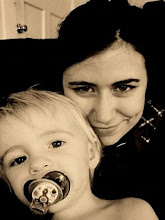i have been pretty concerned that J Bug has night terrors for awhile now.
this article was one that i felt a bit more at ease about. i didnt know they werent actually dreaming. here i am thinking he is terrified...but its just an episode.
jacked from:http://www.justthefactsbaby.com/baby/article/nightmares-night-terrors-and-nighttime-fears/110
f your child’s sleep is disrupted by nightmares and fear, it can affect her mood, behavior, health, memory and growth. Here’s what you can do to solve these common childhood sleep disrupters:
Nightmares
Children spend more time dreaming than adults do, so they have more dreams–both good and bad. After a nightmare, saying “It was just a dream” doesn’t explain what they experienced–after all, most kids believe that the tooth fairy and Big Bird are real, too. After a nightmare, offer comfort just as you would for a tangible fear. If your child wakes with a nightmare:
Stay with her until she feels relaxed and ready to go to sleep, or if she’s reluctant to have you leave, stay with her until she is actually sleeping.
Be calm and convey that what’s happening is normal and that all is well.
Reassure your child that she’s safe and that it’s okay to go back to sleep.
Night terrors
During a night terror, your child will wake suddenly and may scream or cry. Her eyes will be open, but she won’t actually be seeing. She may hyperventilate, thrash around or talk incoherently. She may be sweating and flushed. She may seem scared, but your child is not really frightened, not awake, and not dreaming. She’s asleep and in a zone between sleep cycles. A child having a night terror is unaware of what’s happening, and won’t remember the episode in the morning.
During a night terror you may try to hold your child, but often this will result in her pushing you away or fighting you off. The best response is a gentle pat, along with comforting words or Shhh Shhh sounds. If your child gets out of bed, lead her back. If she’s sitting up, guide her to lie back down. Keep an eye on her until she settles back to sleep.
Nighttime fears
It’s normal for a child to imagine monsters that generate a fear of the dark. Even if you explain that there’s no such thing, and even if you assure her that she’s safe, she may still be scared. You can reduce her fears when you:
Teach her the difference between real and fantasy through discussion and book-reading.
Find ways to help your child confront and overcome her fears. If dark shadows create suspicious shapes, provide a flashlight to keep at her bedside.
Leave soothing lullabies playing, or white noise sounds running to fill the quiet.
Give your child one, two, or a zoo of stuffed animals to sleep with.
Put a small pet, like a turtle or fish, in your child’s room for company.
Take a stargazing walk, build a campfire, or have a candlelight dinner to make the dark more friendly.
Preventing sleep disrupters
Some things have been found to reduce the number or severity of sleep-disturbing episodes. They are all based on good sleep practices and worth a try:
Follow a calm, peaceful routine the hour before bedtime.
Maintain the same bedtime seven days a week.
Avoid books and movies that frighten your child.
Have your child take a daily nap.
Provide your child with a light snack an hour before bedtime, avoiding spicy food, sugar or caffeine.
Have your child use the potty just before she gets into bed.
Is there a time to call a professional?
Always call a professional if you have concerns about your child’s sleep.
Meet our expert:
Elizabeth Pantley is a mother of four and the best-selling author of eight parenting books, including: The No-Cry Sleep Solution and The No-Cry Discipline Solution. She is also a contributing author to The Successful Child with Dr. William Sears. Based in Washington, Pantley is the president of Better Beginnings Inc. (a family resource and education company) and a parenting expert for a variety of publications including: Parents, Parenting and Redbook. www.pantley.com
Subscribe to:
Post Comments (Atom)

No comments:
Post a Comment